Air defense system of the DPRK: anti-aircraft artillery and machine gun installations
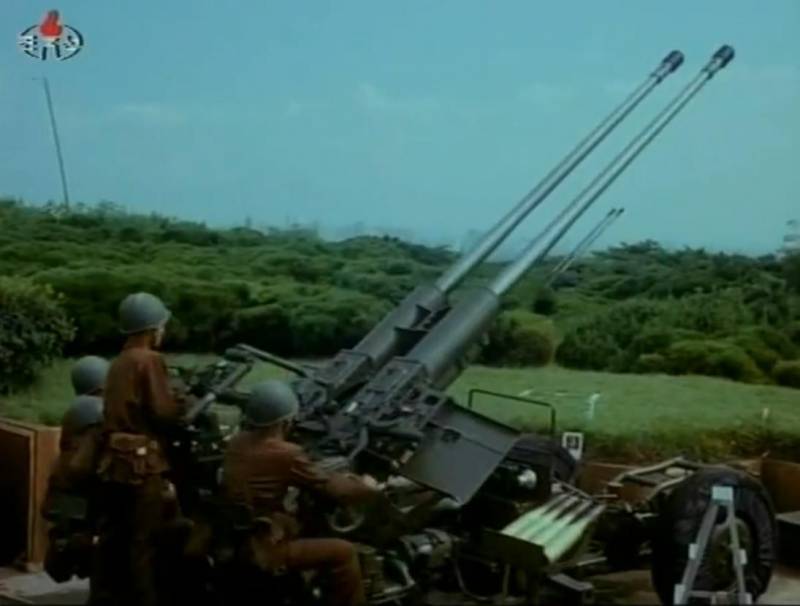
The armed forces of the DPRK have a very significant number of anti-aircraft artillery and machine gun installations, as well as missile systems. But, as in the case of the fighter aviation, most of the ground-based North Korean air defense systems are frankly outdated, and in some places rare samples of the era of the Second World War.
Towed anti-aircraft guns caliber 85-100 mm
Currently, North Korea surpasses all other states in the number of towed anti-aircraft guns and self-propelled artillery installations. According to reference data, there are more than 9000 artillery systems of 23-100 mm caliber in the troops and in storage.
It is noteworthy that the units armed with heavy anti-aircraft guns of 85-100-mm caliber are organizationally subordinate to the Air Force command and are part of the air defense facility. A significant part of large-caliber anti-aircraft guns is installed in well-equipped concrete positions in terms of engineering, where they are constantly on combat duty. According to foreign sources, only Pyongyang is covered by 12 batteries of 100-mm anti-aircraft guns placed in stationary positions. Guns deployed in coastal areas are also considered as anti-amphibious defense assets.
The largest-caliber North Korean anti-aircraft guns are the 100-mm Soviet KS-19M2 and their Chinese copies Type 59. In the 1950-1970s, the Soviet Union transferred five hundred 100-mm anti-aircraft guns to the DPRK. In 1995, another 24 guns were illegally acquired in the Central Asian country, which in the past was one of the Soviet republics.
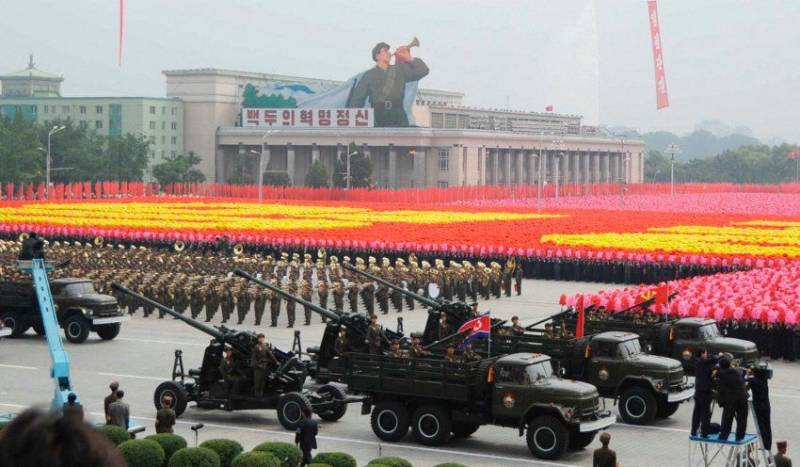
At the time of adoption in 1947, the 100-mm anti-aircraft gun KS-19 was one of the best in its class and could successfully fight an air enemy flying at speeds up to 1200 km/h, at an altitude of up to 15 m.
All elements of the complex in the combat position were interconnected by an electrically conductive connection. Pointing the gun to a preemptive point is carried out by a hydraulic power drive from POISO, but it is possible to point it manually. The installation of the fuse, sending the cartridge, closing the shutter, firing a shot, opening the shutter and extracting the cartridge case are mechanized. Thanks to this, it was possible to achieve a rate of fire of 14-16 rds / min.
Initially, the anti-aircraft battery was attached to the SON-4 gun-laying station, which was a two-axle towed van, on the roof of which there was a rotating antenna in the form of a round parabolic reflector with a diameter of 1,8 m. The detection range of the B-29 Superfortress bomber flying at an altitude of 4000 m was 60 km. Later, a more advanced SON-9A station was used. The effectiveness of firing at air targets was improved due to the introduction of the A3-UZS-56R fragmentation projectile with a radio fuse into the ammunition load.
As the air defense system improved and the troops were saturated with them, the relevance of large-caliber anti-aircraft guns decreased. In the air defense forces of the USSR, 100-mm anti-aircraft guns were abandoned in the mid-1960s. The KS-19 guns remained until the early 1970s in the military air defense.
To tow a gun weighing about 9,5 tons, a heavy tracked tractor and several transport units were required to transport anti-aircraft shells and fuel for diesel generators that ensure the operation of the guns, POISO and SON. In mobility, in terms of the number of personnel required to service an anti-aircraft battery, and in the probability of hitting a target, 100-mm guns were much behind anti-aircraft missile systems. The final withdrawal of the KS-19 to the reserve in the USSR occurred after the adoption of the Krug and Kub mobile military air defense systems.
Nevertheless, the North Korean military has not abandoned 100-mm anti-aircraft guns so far. Moreover, China transferred additional batches of Type 1970 guns in the 1980s and 59s.
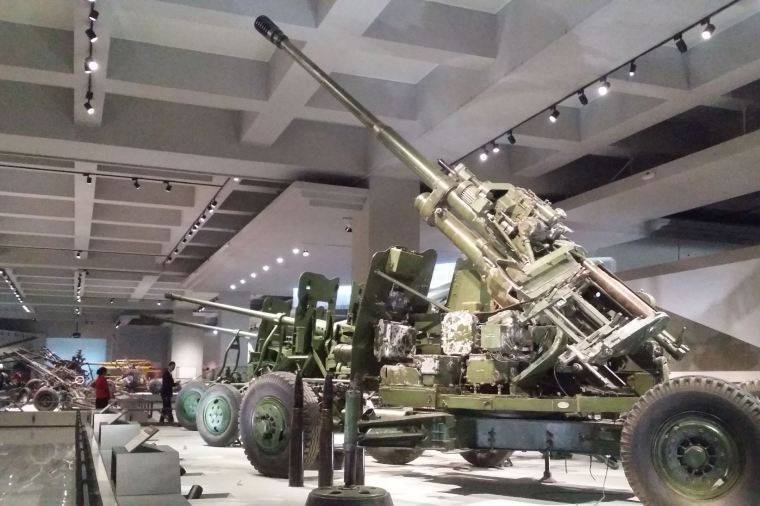
100-mm anti-aircraft gun Type 59 at the Military Museum of the Chinese Revolution
According to the main characteristics, the Chinese Type 59 anti-aircraft gun corresponds to the Soviet KS-19M2 gun. Weight Type 59 in the stowed condition is 9550 kg. In combat - 9450 kg. Projectile weight - 15,6 kg. Initial speed - 900 m / s. The Type 100 59-mm anti-aircraft gun could deal with air targets that had a speed of up to 1200 km / h and flying at an altitude of up to 15 km. Rate of fire - 15 rds / min. Calculation - 7 people.
In the early 1990s, a new centralized aiming station was introduced into the Type 59 six-gun battery. In addition to the radar channel for target detection and the issuance of data for firing, night and day television cameras connected to a laser rangefinder appeared at the station.
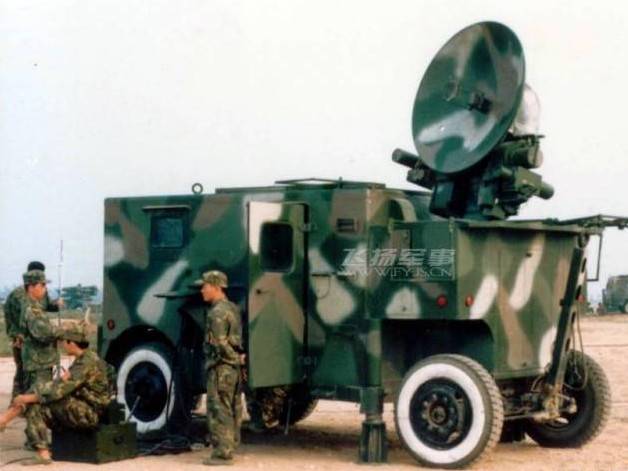
This made it possible to improve the noise immunity and flexibility of the anti-aircraft battery, but did not eliminate the main drawback - poor mobility and long deployment and collapse.
Western reference publications claim that the DPRK still has several hundred 85-mm towed anti-aircraft guns, which are designated as M1939. It is known that in the 1950s the Soviet Union supplied North Korea with a large number of 85-mm 52-K mod. 1939 and KS-12 arr. 1944. There is a possibility that these outdated artillery systems in the DPRK are still in operation.
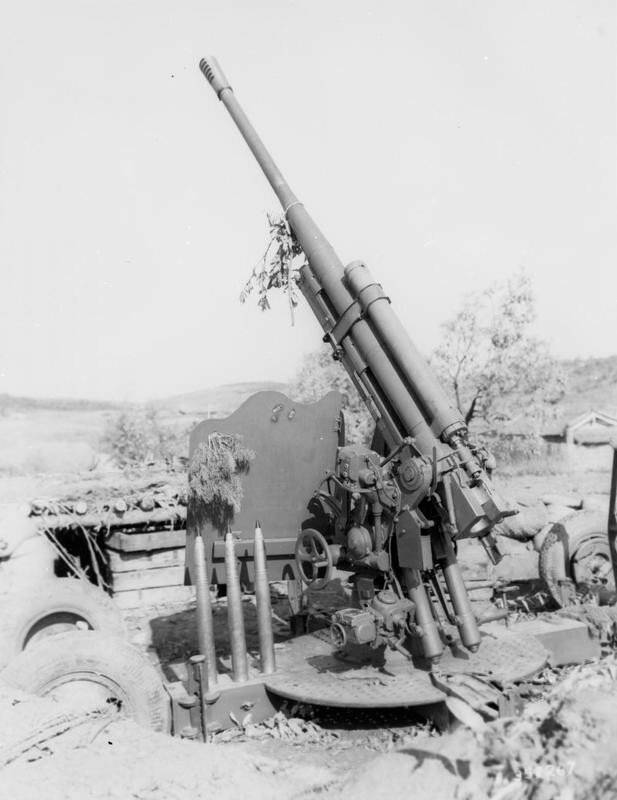
85-mm anti-aircraft gun KS-12 mod. 1944 in combat position without a shield weighed 4300 kg. A fragmentation grenade with a remote fuse weighing 9,2 kg left the barrel with an initial speed of 800 m / s. The reach in height was a little over 10000 m. The rate of fire was up to 20 rds / min. Highway towing speed - up to 50 km / h. Calculation - 9 people.
It is not known whether the North Korean 85-mm anti-aircraft guns have radio-fuzed projectiles in the ammunition load and whether radar stations are used for guidance. Without these options, only barrage anti-aircraft fire is possible, the effectiveness of which is very low.
In the early 1990s, China handed over to the DPRK up to a hundred 85-mm Type 72 guns. This artillery system, which is a reduced copy of the 100-mm Type 59 gun, weighs 6300 kg in transport position, and 5900 kg in combat position. The mass of a fragmentation grenade with a remote fuse is 9,3 kg. Initial speed - 1000 m / s. Rate of fire - up to 35 rds / min. The maximum firing range for air targets is 16 m. The reach in height is 200 m. The calculation of the gun is 12 people.
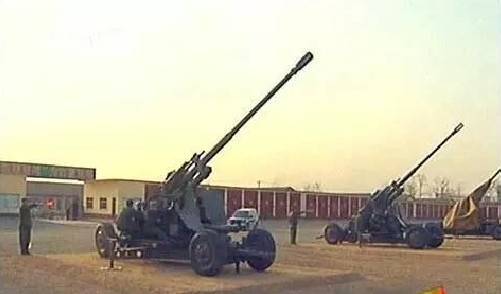
The anti-aircraft battery, in which six Type 72 guns, normally fires according to the anti-aircraft fire control device, coupled with a gun-guided radar and a stereoscopic rangefinder. Created in the PRC, POISOT is capable of remotely pointing guns equipped with electro-hydraulic guidance drives in azimuth and elevation in automatic mode. In case of equipment malfunction or cable damage, guidance is carried out manually by the calculation forces. It is possible to fire at ground and surface targets.
Towed 23-57 mm anti-aircraft guns
At the final stage of the Korean War, the 57-mm anti-aircraft gun AZP-57, which is part of the S-60 anti-aircraft artillery system, took place. The appearance of this gun was due to the fact that during the Second World War there was a “difficult” altitude range for the anti-aircraft guns in service with the Red Army: from 1500 to 3000 m. 25-37-mm guns, this height was too small. In order to solve the problem, it seemed natural to create a rapid-fire anti-aircraft gun of some intermediate caliber. In this regard, the development of a 76-mm gun, which was put into service in 85, began.
Thanks to the use of the ESP-57 centralized system, which synchronizes the remote aiming of guns, on the basis of data received from the radar or optical rangefinder, it was possible to significantly increase the probability of hitting an air target. Compared to the 37-mm 61-K assault rifle, the 57-mm AZP-57 anti-aircraft gun, with a slightly larger mass and a comparable rate of fire, has almost twice the effective range.
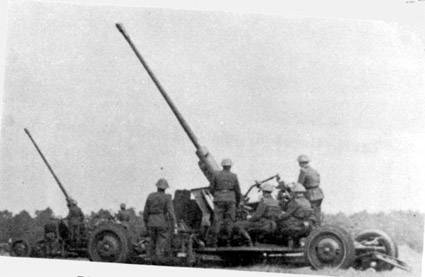
The 57-mm automatic gun AZP-57 in combat position weighs 4,8 tons. The combat rate of fire is 80–90 rds / min. Reach in height - up to 4000 m. Range for air targets - up to 5000 m. Calculation - 8 people.
For firing at air targets, the OR-281 (OR-281U) fragmentation tracer, weighing 2,81 kg, is equipped with an impact fuse with a self-liquidator. Self-liquidation occurred 15-16 seconds after leaving the barrel at a distance of 6,5-7 km.
Against enemy armored vehicles in the ammunition load there is an armor-piercing tracer projectile BR-281 (BR-281U) weighing 2,85 kg. It leaves the barrel with an initial speed of 1000 m/s and at a distance of 1000 meters at a meeting angle of 60° it pierces an armor plate 80 mm thick.
Initially, the six-gun anti-aircraft battery was attached to the gun-guided radar SON-9 or the modernized SON-9A, as well as PUAZO-6-60.
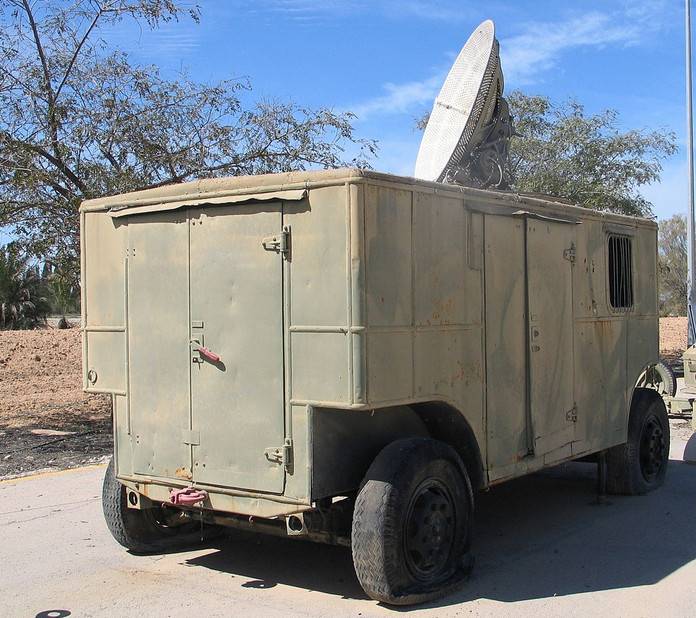
Gun guidance station SON-9
In the 1970s, the old stations were replaced by the RPK-1 Vaza radio-instrument complex on the chassis of the Ural-375 car.
In addition to the Soviet S-60 anti-aircraft artillery systems, North Korea received a significant number of Chinese-made 57-mm Type 57 guns.
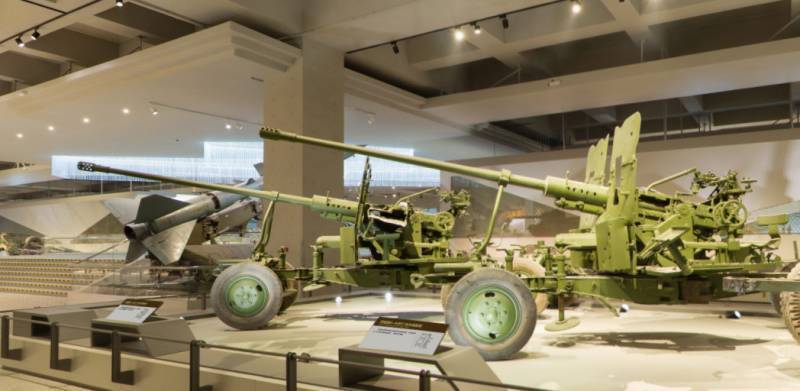
57mm anti-aircraft guns at the War Museum of the Chinese Revolution
According to the main characteristics, the Chinese Type 57 cannon does not differ from the Soviet AZP-57, but some parts are not interchangeable. The Type 57 anti-aircraft battery uses a Chinese-made gun guidance station.
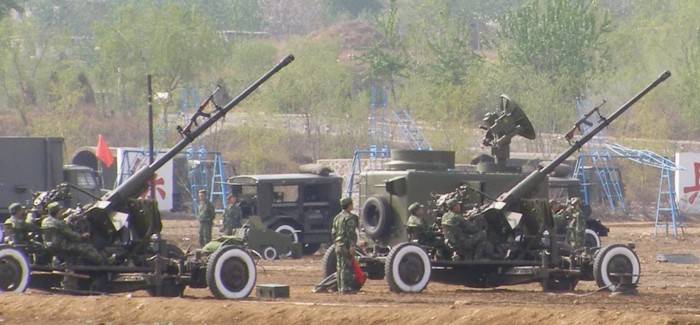
Apparently, the anti-aircraft artillery units of the North Korean army now have more Chinese 57-mm Type 57 guns than the Soviet AZP-57.
Using the AZP-57 artillery unit, twin 57-mm towed artillery mounts were produced in the DPRK.
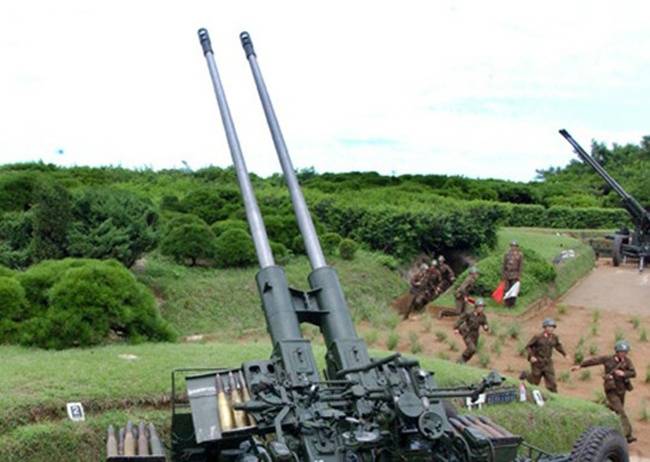
The exact characteristics and name of the 57-mm "sparks" are not known. However, there is reason to believe that this is a North Korean reincarnation of the Soviet S-68 anti-aircraft gun that did not go into the series, equipped with an electric drive associated with a gun guidance station, and placed on a four-wheeled S-79A cart. The mass of the installation in combat position was about 6000 kg. Rate of fire - 480 rds / min. Combat rate of fire - up to 140 rds / min.
The most effective anti-aircraft gun used in 1950-1953. during the fighting on the Korean Peninsula, there was a Soviet 37-mm automatic anti-aircraft gun of the 1939 model of the year (61-K).
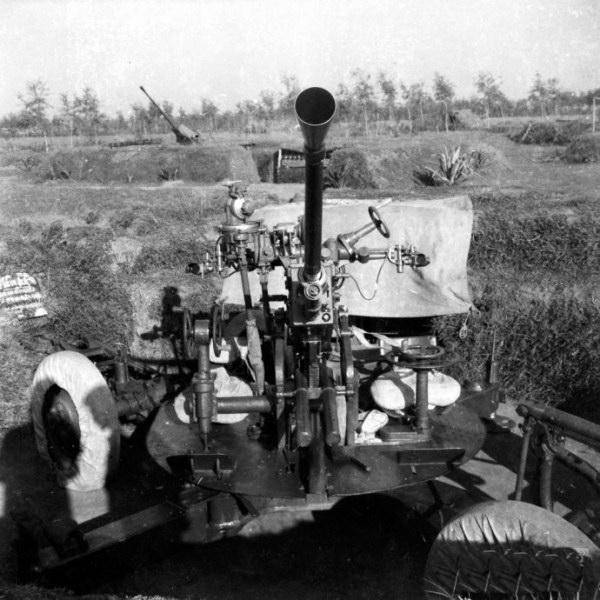
37-mm automatic anti-aircraft gun 61-K in firing position
The Soviet 37-mm automatic gun, based on the Swedish 40-mm Bofors L60 anti-aircraft gun, is capable of hitting air targets at a distance of up to 4000 m and an altitude of 3000 m. The effective range of anti-aircraft fire was about half that. Rate of fire - 160 rds / min. The mass of the gun in combat position without a shield was 2100 kg. Calculation - 7 people.
After the end of the Korean War, the assembly of anti-aircraft guns 61-K was established in the DPRK. There are also more than 500 Chinese 37-mm Type 55s in service, and today various modifications of 37-mm machine guns are the most numerous in the anti-aircraft artillery of the North Korean army.
In addition to the Type 55, twin 1980-mm Type 37 mounts were delivered from China in the early 74s. This anti-aircraft gun was created on the basis of the Type 65, which had much in common with the Soviet B-47. In all these installations, two blocks of barrels of a 37-mm 61-K assault rifle are combined on one carriage. Thanks to this solution, it was possible to significantly increase the practical rate of fire and the probability of hitting the target.
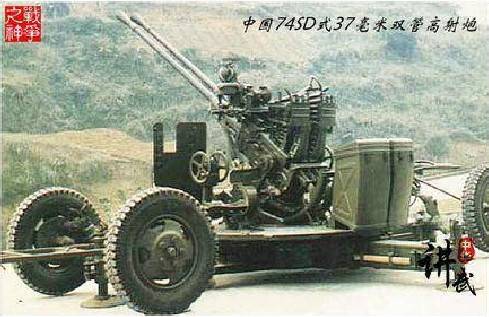
37-mm twin anti-aircraft gun Type 74
The mass of the Type 74 anti-aircraft gun in the stowed position is about 3000 kg, in combat - 2850 kg. Rate of fire - 320-360 rds / min. Calculation - 7 people. The range and reach in height remained at the level of the Soviet 37-mm automatic anti-aircraft gun of the 1939 model.
The Type 74 installation differed from the Type 65 in the ability to work in automatic mode, when the calculations only perform loading. Guidance and firing are carried out from the command anti-aircraft fire control device. For this, the anti-aircraft gun is equipped with tracking remote-controlled electric drives and electromechanical actuators. A towed diesel generator is attached for power supply. Compact gasoline generators can also be used.
The battery has six twin Type 74 anti-aircraft guns connected to the central gun guidance station by cable lines. All implements are located at a distance of no more than 50 m from the distribution cable box.
Reference books say that the North Korean armed forces have 23-mm ZU-23 twin anti-aircraft guns.
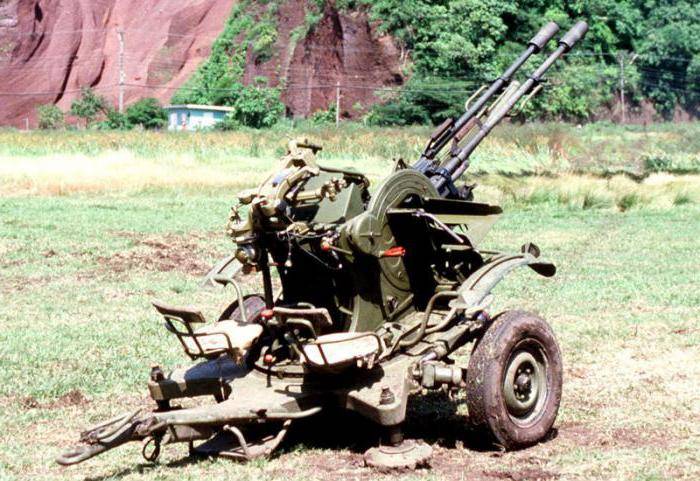
23-mm twin anti-aircraft gun ZU-23 in the stowed position
It is possible that we are talking about a Chinese export clone, known as Type 85. The Type 85 installation is generally identical to the Soviet ZU-23, but has a number of minor design and technological differences. The mass in the stowed state was 950 kg. Rate of fire - 1600 rds / min. Practical rate of fire - 200 rds / min. Firing range at air targets - up to 2500 m. Reach in height - 1500 m.
Anti-aircraft gun mounts
In the 1950s and 1970s, North Korea received several thousand 12,7 mm machine guns that could be used for firing at air targets. These were machine guns supplied with Soviet and Chinese armored vehicles, and also designed to provide air defense for infantry units.
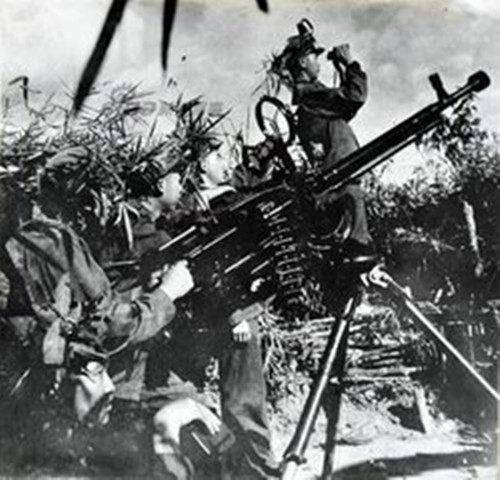
The Soviet Union transferred DShKM heavy machine guns, and China supplied Type 54 and Type 54-1, created on the basis of DShKM.

12,7 mm Type 54-1 machine gun in anti-aircraft firing position
In the 1980s, a certain number of Soviet NSV-12,7s and a package of technical documentation for setting up production were received. However, in the 1990s, after the collapse of the USSR and the cessation of economic support, North Korea faced large-scale economic problems, and it was not possible to establish mass production of NSV-12,7 machine guns in the DPRK.
In the 1950s, the Soviet Union transferred 14,5-mm anti-aircraft guns to North Korea: twin ZU-2 and quad ZPU-4, and China transferred their clones - Type 58 and Type 56.
For firing from these installations, 14,5x114 mm cartridges were used. Bullet weight 60-64 g, muzzle velocity - from 975 to 1005 m / s. The best effectiveness against air targets with armor protection is demonstrated by a cartridge with a B-32 armor-piercing incendiary bullet weighing 64 g. This bullet pierces 20 mm thick armor at an angle of 20 ° from the normal at a distance of 300 m and ignites aviation fuel located behind the armor. The ammunition of the installation may also include 14,5-mm cartridges with an armor-piercing incendiary tracer bullet BST, with an instantaneous incendiary bullet MDZ, with a sighting and incendiary bullet ZP.
The mass of the twin installation ZU-2 in combat position is 640 kg. Rate of fire - 1100-1200 rds / min. Practical rate of fire - up to 300 rds / min. Calculation - 4 people. On the battlefield, the installation is moved by crew forces, and for transportation in mountainous wooded areas, it can be disassembled into parts weighing no more than 80 kg each.
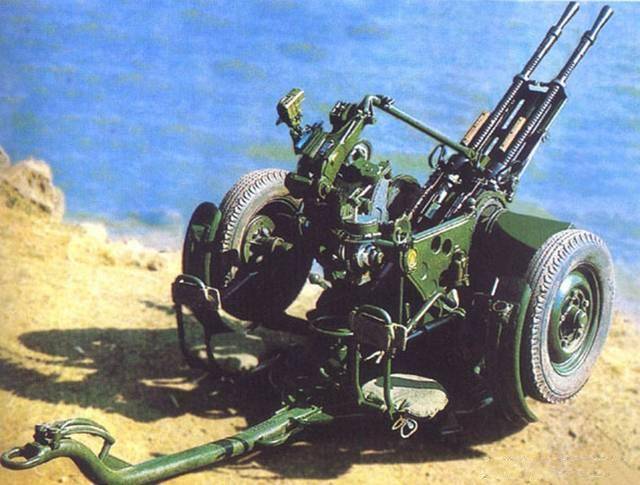
14,5 mm Type 58 twin anti-aircraft machine gun mount
By redesigning the carriage and using light alloys, the mass of the Chinese Type 58 mount was reduced to 580 kg.
In the 1950s-1980s, the Soviet quad 14,5-mm ZPU-4 anti-aircraft gun was very popular in socialist and developing countries. A complete analogue of the ZPU-4 was the Chinese Type 56.
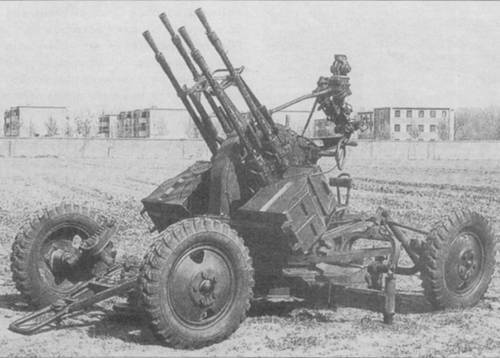
14,5 mm anti-aircraft mount Type 56
Installation Type 56 in combat position weighs a little over 2000 kg. The total rate of fire from four barrels is 2200-2400 rds / min. Rate of fire - up to 1000 rds / min. A kill zone is provided in range of 2000 m, in height - 1500 m. ZPU-4 and Type 56 are towed by light army vehicles. The presence of suspension of the wheels makes it possible to move at high speeds. Calculation - 6 people.
To control the shooting, an automatic anti-aircraft sight of a construction type is used, which has a counting mechanism that takes into account the target's speed, target course and dive angle. This made it possible to quite effectively hit air targets flying at speeds up to 300 m / s.
Quad installations were mainly used in divisions attached to infantry regiments, as well as in anti-aircraft brigades. Usually there were six installations in an anti-aircraft machine gun company.
Currently, 14,5-mm anti-aircraft machine guns are widely used in the armed forces of the DPRK. They are mounted on armored vehicles and combat boats.
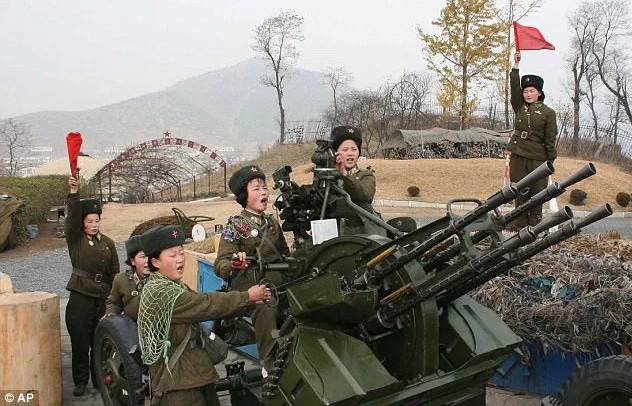
Quadruple installations, served by female crews, are regularly shown on North Korean television and at military parades. Very often, machine gun installations are installed in the back of ZIL-130 trucks.
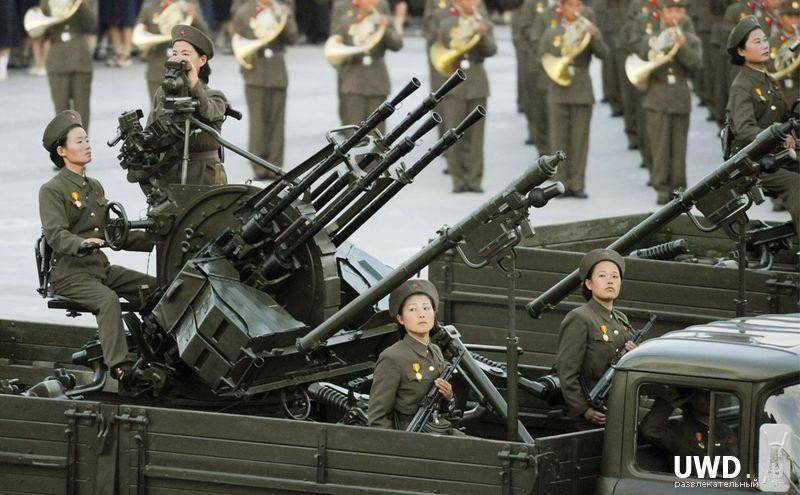
Such an improvised self-propelled unit has high mobility when driving on paved roads, which allows them to be quickly transferred to covered objects.
Anti-aircraft self-propelled artillery installations
The first mass-produced anti-aircraft self-propelled artillery installation in the armed forces of the DPRK was its own analogue of the Soviet ZSU-57-2.
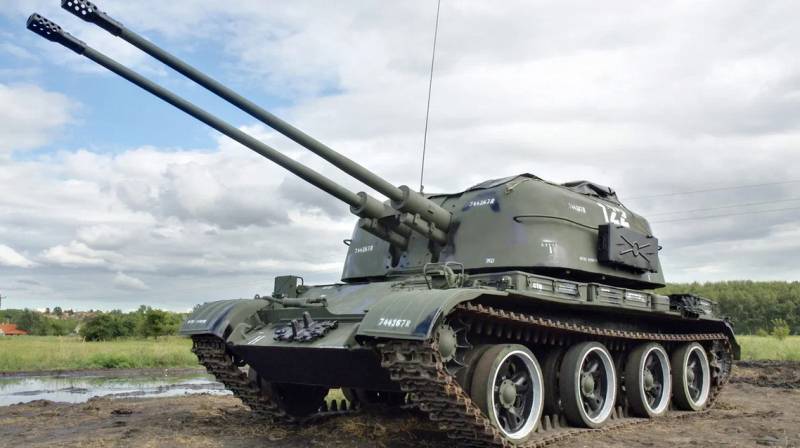
ZSU-57-2
ZSU-57-2 was created on the basis of tank T-54. The armament consisted of a twin S-68 artillery unit, which used 57-mm S-60 guns. The rate of fire of the twin installation reached 480 rds / min. Real rate of fire - up to 140 rds / min.
The mass of the vehicle in the combat position was 28 tons. The internal units and the crew were covered with 8-13 mm bulletproof armor. From above, the tower of the anti-aircraft installation had no armor. Highway speed - up to 50 km / h.
Although the mobility of a caterpillar self-propelled gun armed with two 57-mm anti-aircraft guns increased compared to a towed gun, the effectiveness of an anti-aircraft artillery battery, which had four self-propelled guns, was significantly worse than that of a six-gun S-60 battery. The accuracy of firing was negatively affected by the lack of a radar automated fire control system. When firing at air targets, the crew of an anti-aircraft self-propelled gun determined the range and flight speed visually. In addition, the S-68 twin mount had low angular velocities of aiming the gun at the target.
Western sources claim that in the DPRK in 1968, the assembly of its own versions of the ZSU-57-2 began. Lightly armored turrets with twin S-68 gun mounts, delivered from the USSR, were installed on the undercarriage of Type 59 tanks (a Chinese clone of the T-54). In total, North Korea received 250 anti-aircraft towers.
In the mid-1980s, American intelligence recorded the creation in the DPRK of a self-propelled artillery mount armed with two 57-mm cannons. In foreign reference books, this machine is known as M1985, but, apparently, it was created in the late 1970s. According to South Korean data, about 250 M1985 self-propelled guns were built.
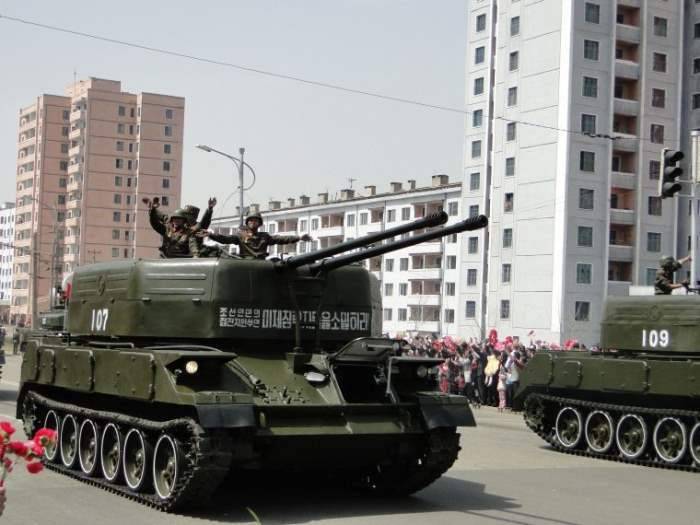
ZSU M1985
Unlike the ZSU-57-2, the North Korean anti-aircraft self-propelled gun is equipped with a different turret, and a chassis very much reminiscent of the GMZ-575 used in the USSR for the ZSU-23-4 "Shilka" is used.
Apparently, this machine is lighter than the ZSU-57-2 and weighs about 20 tons. The maximum speed on the highway is up to 50 km/h. Crew - 4 people. Due to the fact that the self-propelled unit does not have its own radar for detecting air targets and controlling anti-aircraft fire, the firing efficiency is hardly significantly higher than that of the ZSU-57-2. However, there is a possibility that the battery of M1985 self-propelled guns can receive data for firing and be synchronously controlled via radio or cable lines from external gun-guided radar stations, which are similar in capabilities to the Soviet SON-9 or RPK-1. In this case, the accuracy of fire in stationary use will be quite high.
In the 1960s, North Korean engineers created a self-propelled anti-aircraft gun armed with two 37-mm machine guns. This ZSU was first noticed by Western intelligence in 1978 and accordingly received the designation M1978.
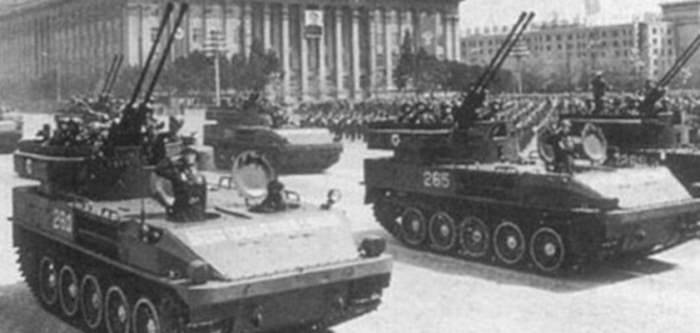
ZSU M1978
Conceptually, the North Korean installation M1978 with an open top turret mounted on a lightly armored chassis corresponds to the American ZSU M19 and M42, armed with two 40-mm cannons. It is known that several M19s used by UN troops during the Korean War to fire at ground targets were captured by the North Korean army.
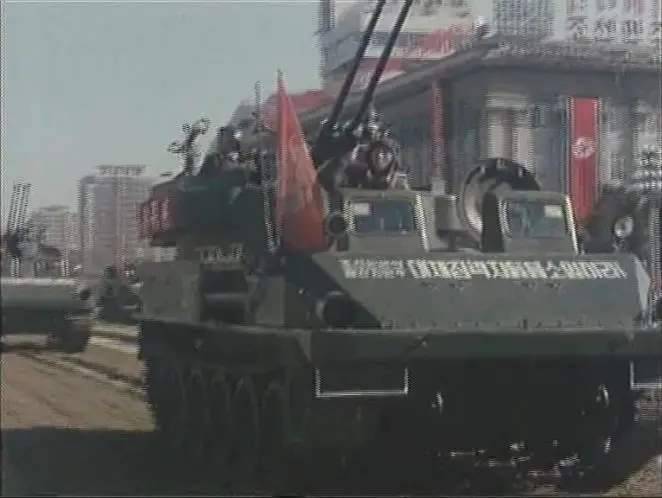
Although the calculation of the M1978 self-propelled gun has only optical sights, which does not correspond to modern realities, these vehicles are still in service.
A number of sources claim that in the DPRK in the 1980-1990s, a number of models of improved ZSUs armed with 37-mm guns were created. However, reliable information about them could not be found.
In the mid-1980s, North Korea received several dozen ZSU-23-4 Shilka. However, these combat vehicles were used to a limited extent and now, apparently, have been withdrawn from service.
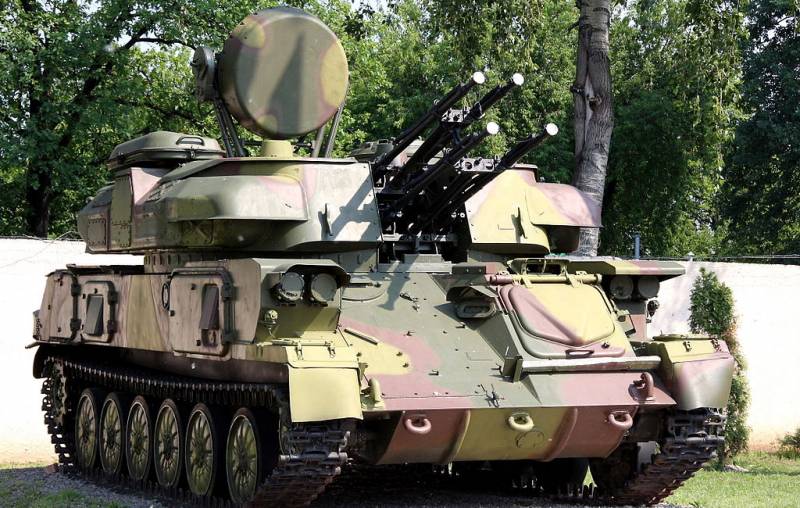
ZSU-23-4 «Shilka»
At the same time, Soviet self-propelled anti-aircraft guns with four 23-mm guns served as a source of inspiration for the creation of a number of North Korean SPAAGs.
A 30-mm self-propelled gun was mass-produced, which is designated as M1992 in Western reference books.
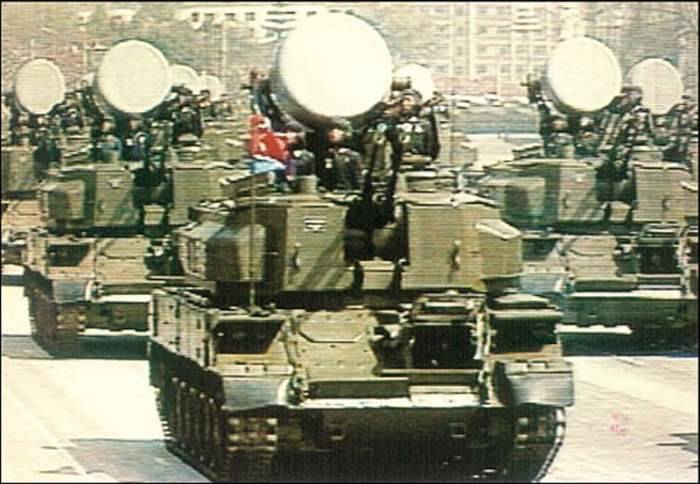
ZSU M1992
The M1992 ZSU uses a tracked chassis, which is an analogue of the GMZ-575. But compared to the ZSU-23-4, the North Korean self-propelled gun is noticeably taller. Instead of 23-mm 2A7 assault rifles, two 30-mm HN-30 cannons, used as part of the AK-230 naval artillery mount, are installed in the oversized turret.
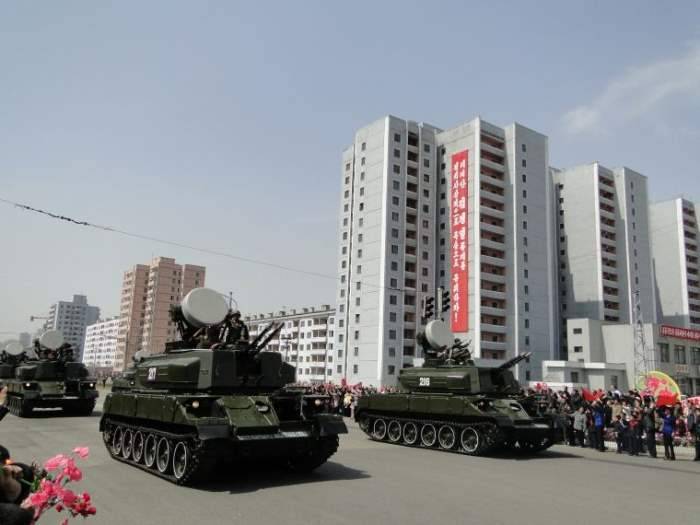
Rate of fire - up to 1000 rds / min per barrel. The effective range for air targets is about 3000 m. Apparently, the hardware of the ZSU M1992 was copied with minimal changes from the Soviet ZSU-23-4. As well as on the Shilka, the detection range does not exceed 20 km, and taking a target for escort is possible from 15 km.
Western experts believe that the weight of the North Korean ZSU is about 20 tons. The diesel engine with a capacity of 280 liters. With. can accelerate the car on the highway up to 50 km / h. There is an auxiliary power unit that powers all systems when the main engine is turned off. Crew - 4 people.
To be continued ...
Information